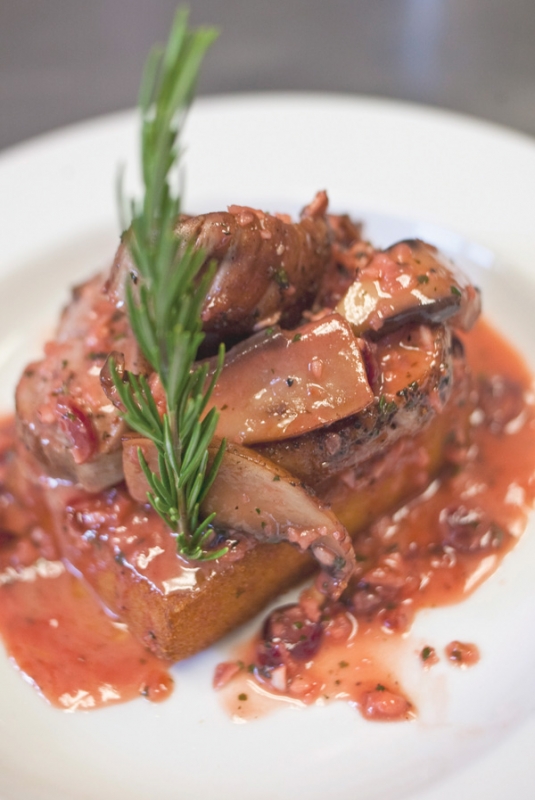10 Years of Stoneground
Food Reviews
249 East 400 South
Salt Lake City, Utah 84111
801-364-1368
Fax 801-531-7255
Hours: Mon-Sat 11am-11pm
Sin Sunday: 5pm-9pm – a sinful dining experience of pizza and salad (regular menu not available)
At this point, the location of Stoneground really shouldn’t be a secret. But since it’s tucked away downtown on the second floor of an older building, one that overlooks the Salt Lake Library and a Trax station, it is easy to drive straight by without ever seeing the large rust-colored sign.
In June, Stoneground celebrated its tenth anniversary. And while this is an incredible feat for any restaurant, it is even more impressive when you consider the eatery’s humble beginnings and the adversity it has faced over the past decade.
When owner Bob McCarthy moved to Salt Lake City in 1992, the last thing on his mind was opening a restaurant. “I was a ski bum. I moved here from upstate New York to ski and to go to school.” To finance his winters on the slopes, McCarthy took as many odd jobs as he could, earning money in part by working with contractors and by painting commercial buildings.
This was how he came into contact with the space that would eventually become his restaurant—he painted it. At the time the facility was owned by John Bolton, a commercial real estate man who had made his money as a member of the local Epicurious restaurant group. “The building was an original location of the Salt Lake Roasting Company—it was one of the first coffee roasting facilities in Utah,” McCarthy says. There had been some fire damage to the structure and it had been renovated to house a second story restaurant.

This possibility got McCarthy thinking. His few years in Utah had convinced him that Salt Lake City needed a family-style Italian restaurant, like the ones he remembered from growing up around Albany. He explained, “there were Italian restaurants in Salt Lake, and the food was really good, but you knew you were going to have to spend a lot of money if you ate there.
It was all fine dining—there wasn’t a reasonably priced, authentic family-run restaurant anywhere in the city and I thought there should be.” He pitched his idea to the building’s owner and before he knew it he was opening Stoneground. The second floor was already set up to be used as an eatery.
Bolton also had a warehouse full of old restaurant equipment and was willing to work with McCarthy on finances, agreeing to take a percentage of the earnings until the place got up and running. The inspiration for the majority of the early menu came from the Italian side of McCarthy’s family, and he and his cousin essentially did everything to run the place. “It was more work than I ever thought it would be.
It was devastating to my lifestyle. I was there from open until close most days. I worked 70 hour weeks for four or five years.” It should also be noted that McCarthy opened Stoneground without ever having worked in the food service industry. He was good at being social, and enjoyed being a host, especially one that offered food and libations to customers, but the first day the restaurant opened was his first day working in a restaurant. This was a daunting task.
Inexperience wasn’t the only challenge. Stoneground’s proximity to several churches and a public library made getting a liquor license an 18 month legal ordeal. With that hurdle overcome, they now offer an impressive list of beer and wine.
The early days also saw extended road closures as the city constructed the new library square and tore up 400 South to put in a Trax line. There was also the location and layout of the building. Statistically speaking, restaurants not located on the street level almost always do poorly. This coupled with a lack of street parking and a parking lot that wasn’t visible from the front of the building made it especially challenging to attract walk-in business.
Stoneground was on the cusp of closing for years, but as more people found them, word of mouth spread. Today the restaurant enjoys many regular customers. The servers and kitchen workers tend to stick around for years at a time, something that rarely happens in the restaurant business. It has become a gem of a restaurant in the heart of downtown.
The result has been the creation of the very same family-run feel that McCarthy had hoped to capture when he opened the restaurant in 2000. The combination of quality food and the familiarity of the staff makes for a genuinely warm experience.
I have often thought of Stoneground as a pizzeria. They offer two sizes of pizza, 12 and 16 inch versions, with specialty varieties that range in price from $10 to $19. There is, of course, the possibility of customizing your pie however you’d like it, but the list of family and staff favorites on the menu is a truly eclectic, sample-worthy assortment.
A popular choice is the Forest Mushroom and Goat pizza ($13/$19) that includes portobello, porcini, and button mushrooms with goat and mozzarella cheeses, and your choice of tomato or pesto sauce. I have always loved this pizza. I’m a sucker for the tangy bite of goat cheese, and feel that the trio of mushrooms and the basil-walnut pesto pair beautifully together.
There are plenty of options for those who don’t favor mushrooms, like owner Bob McCarthy. I asked him which pizza he preferred and he pointed to the one that was named after him. Bob’s Late Night ($12/$17) features Stoneground’s signature New York-style crust topped with pepperoni, jalapeno slices, fresh tomatoes, sauce and mozzarella cheese.
In preparation for this review I branched out and ordered the Moon Dog ($13/$17). Another well-liked pie, the Moon Dog features sausage, caramelized onions, tomato sauce and agrodolce peppers. The sweetness of the onions and the peppers cut the heaviness of the sausage, and the resulting pie is as pleasant to eat as it is to share.
But Stoneground is more than just a pizza place. Today’s menu is the culmination of what has and hasn’t worked over the past ten years, with a handful of chef’s specials becoming permanent menu items. Though it is still a mostly Italian restaurant, you can start your meal with fried-to-order tortilla chips and house-made salsa ($5). The chips are served warm and the salsa strikes a good balance between sweet and spicy.
When you run out of chips, and you will, a second bowl is available for a nominal fee. Another slightly non-traditional dish is the Pork Tenderloin ($16). This entrée consists of a generous portion of brined, roasted pork tenderloin served over a thick slab of grilled polenta and finished with a creamy portobello, dried cranberry and red wine sauce. Everything about it is tremendous.
The savory and tender pork matches up perfectly with the crisp-on-the-outside, creamy-on-the-inside polenta. The pan-grilled crust of the corn polenta holds up well under the weight of the meat and the acidity of the sauce. You’ll want to ask your server to bring out some bread, because there is no way a single drop of the mushroom-cranberry-wine sauce should escape from being eaten.
As daring as these choices sound, it is the Italian fare, the traditional family-inspired selections that are the most popular. Time-honored classics like Chicken Parmesan and Eggplant Parmesan ($13) continue to bring in diners. The pasta dishes are also spectacular. The Lemon Caper Linguini ($14) allows for the customer to choose between grilled chicken or shrimp, to be served over al dente pasta in a lemon butter and caper sauce.
And then there’s the one that tugs on the heart strings: Grandma’s Pasta ($10). This is an exceptionally authentic Italian dish—something very typical of a family kitchen setting. McCarthy noted that this was the exact dish that his grandmother made for over seventy years and was something that she prepared for his grandfather on an almost daily basis.
It is a simple yet elegant combination of thin cappelini noodles and roasted garlic, olive oil, fresh herbs, butter and asiago cheese. It may leave you with that familiar garlic afterburn, but that is a small price to pay for pasta this graceful. Upon hearing that this was a dish that McCarthy’s grandmother had perfected over a seventy year period, my wife had this to say: “I could eat this everyday for seventy years.” So could I—It’s that good.
After surviving its first couple of years, Stoneground has really hit its stride. The past five years have been better and more profitable for everyone involved. McCarthy was fortunate enough to have been able to buy the building that houses the restaurant and to give the parking area some much needed attention.
He was also able to lend some financial backing to friend Brian Morris’ dream of opening an upscale, smoke-free, gay-friendly club. The resulting business, Jam in the Marmalade (751 North 300 West), helps to provide a hospitable and fashionably chic nightclub environment for Salt Lake’s DJ and dance crowd. More recently, McCarthy purchased and has started to renovate the Jimax Lounge.
Located on the northwest side of Capitol Hill at 1199 Beck St, Jimax is a work in progress. It butts up against the oil refinery in an industrial area, free from many of the zoning issues found downtown. McCarthy hopes to turn it into a roadhouse-style bar. He’s keeping it open during the renovations and plans to rechristen it the Garage early next year.
When asked to what he owed his success in the restaurant business, he said it was a result of trying to create a place that would be a destination. “I remember places like the Dead Goat, Bill & Nada’s and Junior’s Tavern,” he said. “I wanted a place you would want to take your family when they came to town—someplace different.” And to what does he attribute Stoneground’s endurance? Distinctness and character. “It has to come from your heart and soul. And it has to be unique. If you can pull off unique then you can get longevity.”
